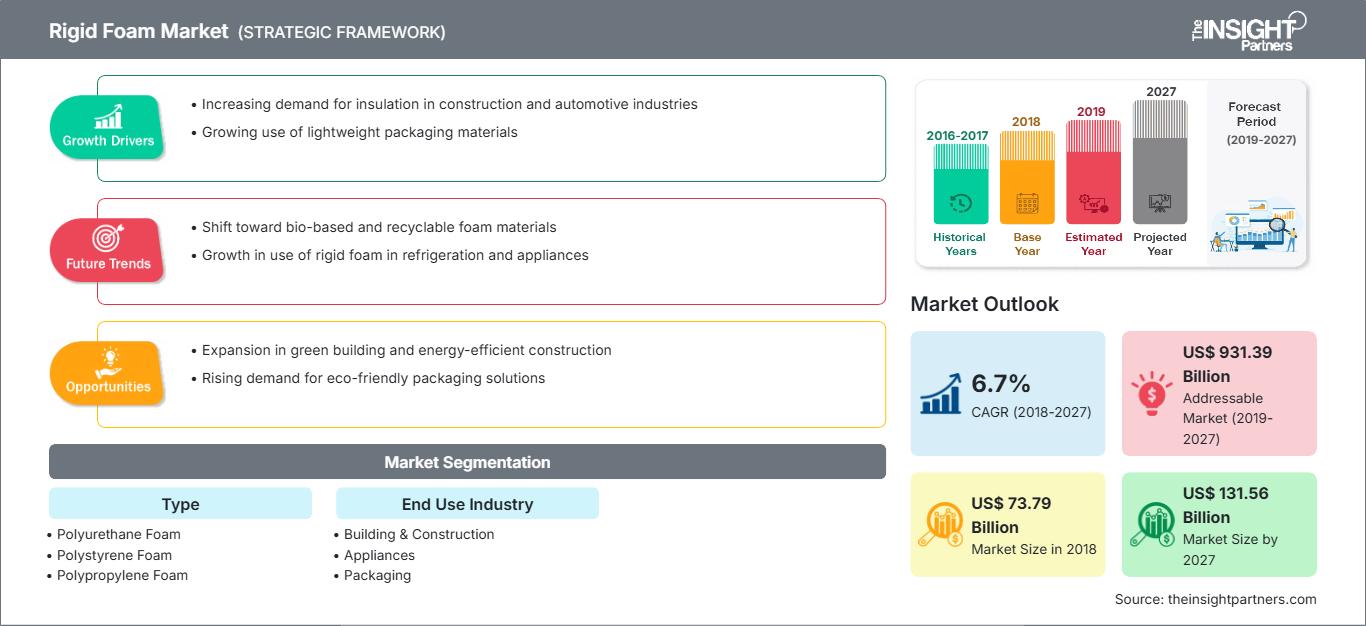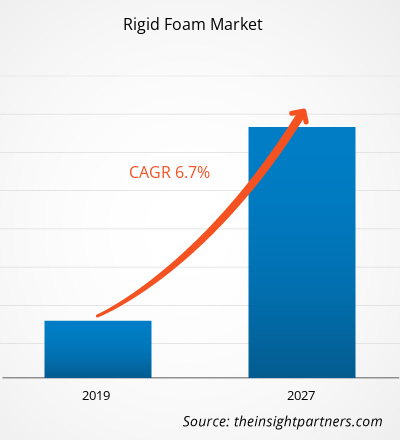[Rapporto di ricerca]Il mercato della schiuma rigida ha rappresentato 73.786,7 milioni di dollari nel 2018 e si prevede che crescerà a un CAGR del 6,7% nel periodo di previsione 2019-2027, fino a raggiungere i 131.558,9 milioni di dollari entro il 2027.
Le schiume rigide sono note per possedere diverse proprietà, come impermeabilità, antistatiche, antivibrazioni e antiscivolo, che le rendono un materiale ideale per l'utilizzo in molti settori industriali e edili. La schiuma rigida protegge le superfici in calcestruzzo su cui viene applicata e prolunga la durata dei pavimenti in calcestruzzo sottostanti. È inerte a oli, detergenti e detergenti, fluidi di trasmissione, acqua, grandine, neve e sostanze chimiche corrosive. La schiuma rigida viene utilizzata anche per migliorare l'aspetto estetico del pavimento. È disponibile in diversi colori, tonalità e texture. Pigmenti metallici e scaglie di colore vinilico vengono aggiunti ai sistemi di schiuma rigida per produrre superfici dai colori iridescenti. Si prevede che l'appeal estetico della schiuma rigida colorata guiderà il mercato della schiuma rigida e il suo utilizzo è sempre più diffuso nei nuovi progetti edilizi e nelle ristrutturazioni di vecchie case.
Nel 2018, l'area Asia-Pacifico deteneva la quota maggiore del mercato globale delle schiume rigide. Questa crescita del mercato nell'area Asia-Pacifico è principalmente attribuibile alla presenza di importanti produttori di schiuma rigida nella regione. Inoltre, si prevede che l'aumento delle attività produttive di schiuma rigida alimenterà la crescita del mercato tra il 2019 e il 2027. Nell'area Asia-Pacifico, la Cina ha rappresentato la quota maggiore di schiume rigide in termini di fatturato generato.
Personalizza questo rapporto in base alle tue esigenze
Potrai personalizzare gratuitamente qualsiasi rapporto, comprese parti di questo rapporto, o analisi a livello di paese, pacchetto dati Excel, oltre a usufruire di grandi offerte e sconti per start-up e università
Mercato della schiuma rigida: Approfondimenti strategici

-
Ottieni le principali tendenze chiave del mercato di questo rapporto.Questo campione GRATUITO includerà l'analisi dei dati, che vanno dalle tendenze di mercato alle stime e alle previsioni.
Negli ultimi anni si sono registrati rapidi progressi nel campo dei polimeri, con un aumento della produzione di materie plastiche e polimeri. Si prevede che una tendenza al rialzo nell'industria dei polimeri genererà un'elevata percentuale di scarti di polimeri. Inoltre, sono state emanate nuove norme e regolamenti sulla scia della tutela ambientale, che stanno spingendo scienziati e imprenditori a cercare soluzioni alternative per la gestione e il trattamento dei rifiuti plastici o l'adozione di plastiche biodegradabili che potrebbero decomporsi nell'ambiente naturale. Tra i diversi tipi di plastiche biodegradabili prodotte in tutto il mondo, il polilattide (PLA) è considerato una delle forme preferite di bioplastiche. I rifiuti generati da queste plastiche possono essere facilmente trasformati in un prodotto di valore aggiunto come le schiume rigide di poliuretano-poliisocianurato (RPU/PIR). Tali schiume prodotte da polilattide biodegradabile sono considerate soluzioni sostenibili. Secondo uno studio presentato da Europe PMC, il polilattide può sostituire parzialmente il poliolo petrolchimico nella formulazione del poliisocianurato. Inoltre, le schiume PIR ottenute possiedono diverse caratteristiche, come densità apparente minima, fragilità e capacità di assorbimento d'acqua. Pertanto, l'uso di poliolo PLA composto da rifiuti plastici può rappresentare un'ottima alternativa ai polioli petrolchimici. Tali sviluppi contribuiscono alla gestione delle risorse limitate e all'utilizzo efficace dei rifiuti. Inoltre, i prodotti realizzati con tale biomateriale sono considerati soluzioni ecocompatibili.
Approfondimenti sulle tipologie
In base alla tipologia, il mercato delle schiume rigide si divide in schiuma di poliuretano, schiuma di polistirene, schiuma di polipropilene, schiuma di polietilene, schiuma di polivinilcloruro e altre. Il segmento della schiuma di poliuretano ha dominato il mercato globale delle schiume rigide. La schiuma di poliuretano rigida è ampiamente utilizzata nei settori della refrigerazione, dell'edilizia e dell'imballaggio grazie alle sue eccellenti proprietà isolanti e alla buona stabilità dimensionale.
Approfondimenti sul settore di utilizzo finale
Il mercato della schiuma rigida è suddiviso in base al settore di utilizzo finale: edilizia, elettrodomestici, imballaggi, automotive e altri. Il segmento dell'edilizia rappresenta la quota maggiore del mercato globale della schiuma rigida. Il suo utilizzo nella costruzione di case ed edifici riduce l'energia necessaria per il riscaldamento e il raffreddamento degli spazi interni di edifici, negozi e uffici. Si prevede che il crescente consumo di schiume rigide da parte del settore dell'edilizia sosterrà la crescita del mercato globale della schiuma rigida durante il periodo di previsione.
Diverse strategie vengono comunemente adottate dalle aziende per espandere la propria presenza a livello mondiale. Huntsman Corporation, Covestro e BASF SE sono tra i principali attori del mercato globale della schiuma rigida che implementano queste strategie per ampliare la base clienti e acquisire una quota significativa, il che, a sua volta, consente loro di mantenere il proprio marchio a livello globale.
Approfondimenti regionali sul mercato della schiuma rigida
Le tendenze regionali e i fattori che influenzano il mercato della schiuma rigida durante il periodo di previsione sono stati ampiamente spiegati dagli analisti di The Insight Partners. Questa sezione illustra anche i segmenti e la geografia del mercato della schiuma rigida in Nord America, Europa, Asia-Pacifico, Medio Oriente e Africa, America meridionale e centrale.
Ambito del rapporto sul mercato della schiuma rigida
| Attributo del rapporto | Dettagli |
|---|---|
| Dimensioni del mercato in 2018 | US$ 73.79 Billion |
| Dimensioni del mercato per 2027 | US$ 131.56 Billion |
| CAGR globale (2018 - 2027) | 6.7% |
| Dati storici | 2016-2017 |
| Periodo di previsione | 2019-2027 |
| Segmenti coperti |
By Tipo
|
| Regioni e paesi coperti |
Nord America
|
| Leader di mercato e profili aziendali chiave |
|
Densità degli operatori del mercato della schiuma rigida: comprendere il suo impatto sulle dinamiche aziendali
Il mercato della schiuma rigida è in rapida crescita, trainato dalla crescente domanda degli utenti finali, dovuta a fattori quali l'evoluzione delle preferenze dei consumatori, i progressi tecnologici e una maggiore consapevolezza dei vantaggi del prodotto. Con l'aumento della domanda, le aziende stanno ampliando la propria offerta, innovando per soddisfare le esigenze dei consumatori e sfruttando le tendenze emergenti, alimentando ulteriormente la crescita del mercato.

- Ottieni il Mercato della schiuma rigida Panoramica dei principali attori chiave
- Le tendenze progressive del settore nel mercato della schiuma rigida aiutano gli operatori a sviluppare strategie efficaci a lungo termine
- Strategie di crescita aziendale adottate dai mercati sviluppati e in via di sviluppo
- Analisi quantitativa del mercato della schiuma rigida dal 2017 al 2027
- Stima della domanda di schiuma rigida in vari settori
- Analisi PEST per illustrare l'efficacia di acquirenti e fornitori che operano nel settore nel prevedere la crescita del mercato
- Sviluppi recenti per comprendere lo scenario competitivo del mercato e la domanda di schiuma rigida
- Tendenze e prospettive di mercato insieme ai fattori che guidano e frenano la crescita del mercato della schiuma rigida
- Comprensione delle strategie che sostengono l'interesse commerciale per quanto riguarda la crescita del mercato della schiuma rigida, che facilita il processo decisionale per le dimensioni del mercato della schiuma rigida degli stakeholder in vari nodi del mercato
- Panoramica dettagliata e segmentazione del mercato della schiuma rigida, nonché le sue dinamiche nel industria
Mercato globale della schiuma rigida - per tipo
- Schiuma di poliuretano
- Schiuma di polistirene
- Schiuma di polipropilene
- Schiuma di polietilene
- Schiuma di cloruro di polivinile
- Altri
Mercato globale della schiuma rigida - per settore di utilizzo finale
- Edilizia e Edilizia
- Elettrodomestici
- Imballaggi
- Automotive
- Altro
Profili aziendali
- Saint-Gobain
- Dow Chemical Corporation
- BASF SE
- Borealis AG
- Sekisui Chemical Co.,Ltd
- Covestro AG
- Armacell International SA
- Huntsman International LLC
- JSP
- Zotefoams Plc
- Analisi storica (2 anni), anno base, previsione (7 anni) con CAGR
- Analisi PEST e SWOT
- Valore/volume delle dimensioni del mercato - Globale, Regionale, Nazionale
- Industria e panorama competitivo
- Set di dati Excel
Report recenti
Testimonianze
Motivo dell'acquisto
- Processo decisionale informato
- Comprensione delle dinamiche di mercato
- Analisi competitiva
- Analisi dei clienti
- Previsioni di mercato
- Mitigazione del rischio
- Pianificazione strategica
- Giustificazione degli investimenti
- Identificazione dei mercati emergenti
- Miglioramento delle strategie di marketing
- Aumento dell'efficienza operativa
- Allineamento alle tendenze normative






















 Ottieni un campione gratuito per - Mercato della schiuma rigida
Ottieni un campione gratuito per - Mercato della schiuma rigida